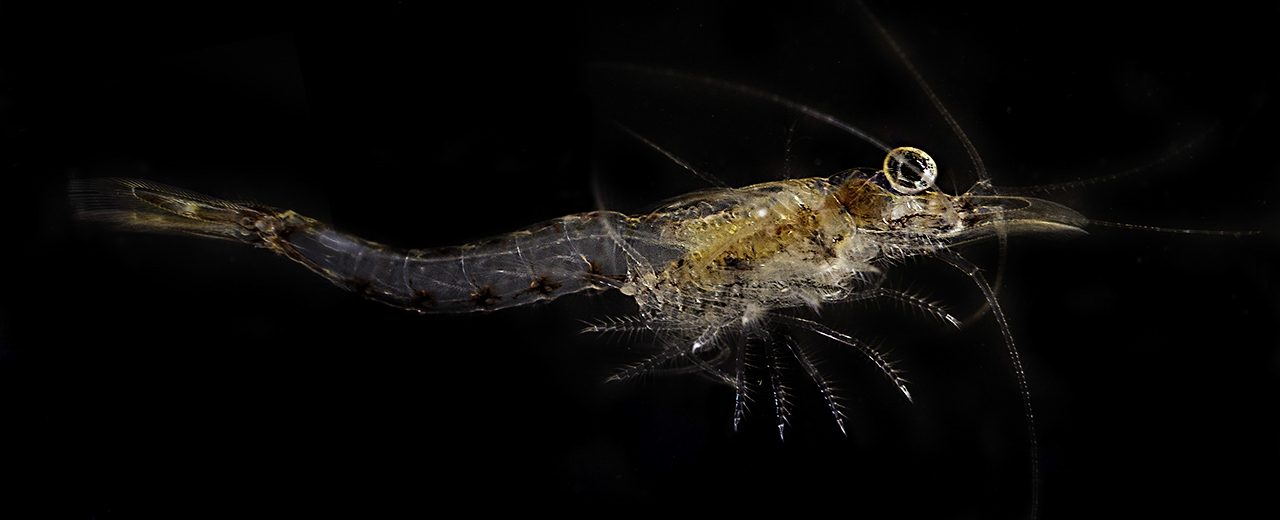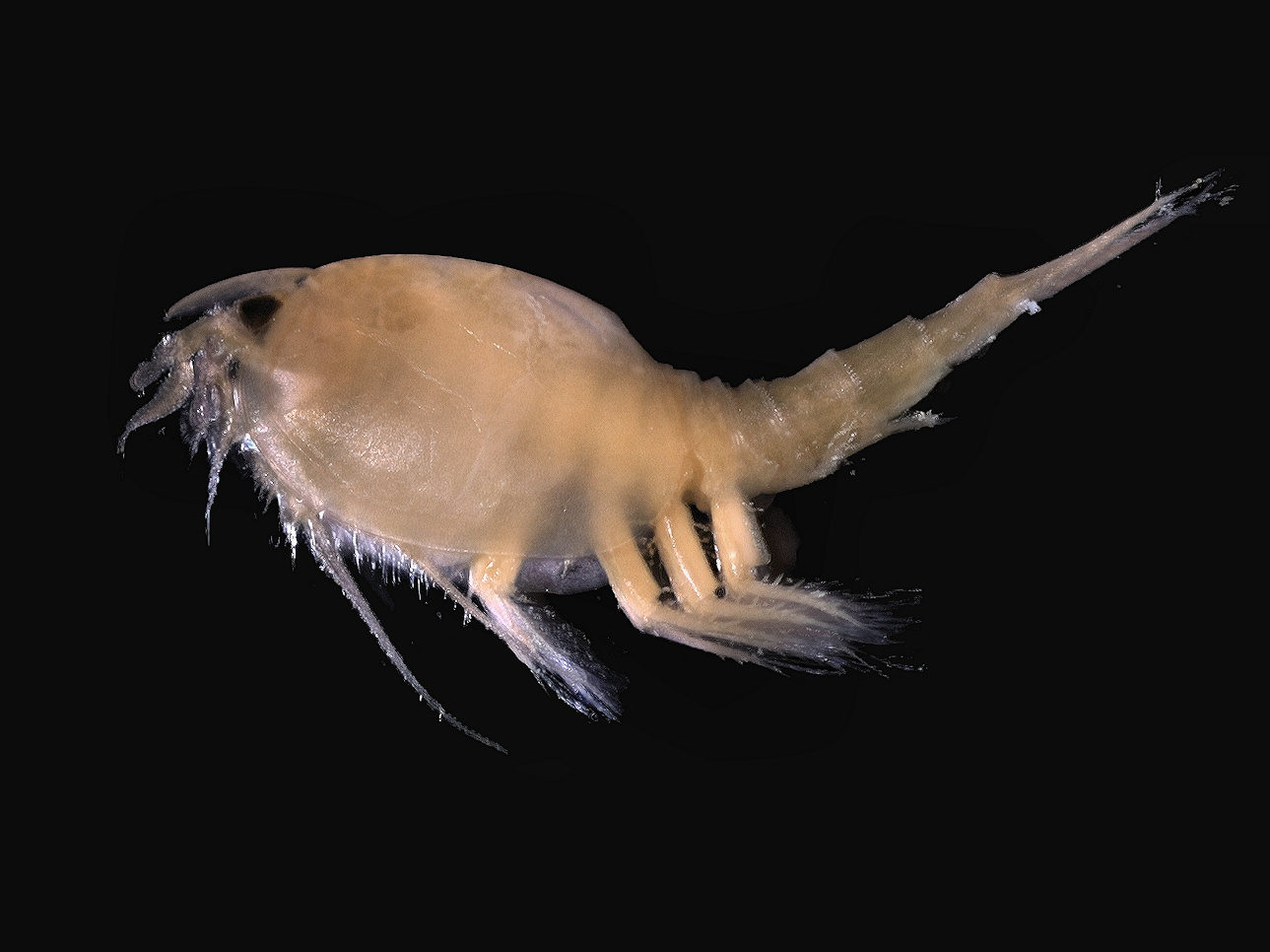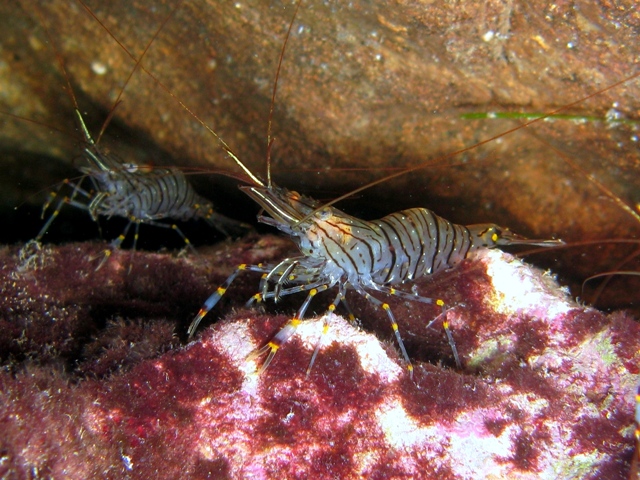|
Mysida
Mysida is an order (biology), order of small, shrimp-like crustaceans in the malacostracan superorder Peracarida. Their common name opossum shrimps stems from the presence of a Brood pouch (Peracarida), brood pouch or "marsupium" in females. The fact that the Crustacean larvae, larvae are reared in this pouch and are not Motility, free-swimming characterises the order. The mysid's head bears a pair of stalked eyes and two pairs of antennae. The thorax consists of eight segments each bearing branching limbs, the whole concealed beneath a protective carapace and the abdomen has six segments and usually further small limbs. Mysids are found throughout the world in both shallow and deep marine waters where they can be Benthos, benthic or pelagic, but they are also important in some fresh water and brackish water, brackish ecosystems. Many benthic species make Diel vertical migration, daily vertical migrations into higher parts of the water column. Mysids are filter feeders, omnivores ... [...More Info...] [...Related Items...] OR: [Wikipedia] [Google] [Baidu] |
Mysidae
Mysidae is the largest family of crustaceans in the order Mysida, with over 1000 species in around 170 genera. Characteristics Members of the family Mysidae are distinguished from other mysids by the fact that the first pereopod (walking leg) has a well-developed exopod (outer branch), the carpopropodus of the endopod (inner branch) of the 3rd to 8th pereopods is divided into sub-segments and there are statocysts on the endopod of the uropod Uropods are posterior appendages found on a wide variety of crustaceans. They typically have functions in locomotion. Definition Uropods are often defined as the appendages of the last body segment of a crustacean. An alternative definition sugge ...s (posterior appendages). Female petalophthalmidans have two or three oostegites (flexible bristly flaps) forming the base of the marsupium or brood pouch under the thorax, apart from the subfamily Boreomysinae, which has seven pairs of oostegites. Subfamilies and genera The following subfami ... [...More Info...] [...Related Items...] OR: [Wikipedia] [Google] [Baidu] |
Peracarida
The superorder Peracarida is a large group of malacostracan crustaceans, having members in marine, freshwater, and terrestrial habitats. They are chiefly defined by the presence of a brood pouch, or ''marsupium'', formed from thin flattened plates ( oostegites) borne on the basalmost segments of the legs. Peracarida is one of the largest crustacean taxa and includes about 12,000 species. Most members are less than in length, but the largest is probably the giant isopod ('' Bathynomus giganteus'') which can reach . The earliest known perecaridian was '' Oxyuropoda ligioides'', a fossil of which has been found dating to the Late Devonian (more than 360 mya) of Ireland. Characteristics The most obvious characteristic of the group is the marsupium in females. This brood pouch is enclosed by the large, flexible oostergites, bristly flaps which extend from the basal segments of the thoracic appendages, which form the floor of a chamber roofed by the animal's sternum. This chamber ... [...More Info...] [...Related Items...] OR: [Wikipedia] [Google] [Baidu] |
Hemimysis Anomala
The bloody-red mysid, ''Hemimysis anomala'', is a shrimp-like crustacean in the Mysida Order (biology), order, native to the Ponto-Caspian region, which has been spreading across Europe since the 1950s. In 2006, it was discovered to have invasive species, invaded the North American Great Lakes. Distribution The species is native to freshwater margins of the Black Sea, the Azov Sea and the eastern Caspian Sea. It has historically occurred in the lower reaches of the Don River (Russia), Don, Danube, Dnieper and Dniester rivers. In Europe, it has recently spread north west, reaching the Baltic Sea in 1992 and the United Kingdom in 2004. The mysid's spread has been facilitated via its deliberate introduction into reservoirs on the Volga and Dnieper rivers in the 1950s and 1960s to serve as fish food. Despite its spread throughout Europe, it is considered to be endangered in some parts of its indigenous range (Ukraine). The species has entered the Great Lakes via the ballast water exch ... [...More Info...] [...Related Items...] OR: [Wikipedia] [Google] [Baidu] |
Malacostraca
Malacostraca is the second largest of the six classes of pancrustaceans behind insects, containing about 40,000 living species, divided among 16 orders. Its members, the malacostracans, display a great diversity of body forms and include crabs, lobsters, spiny lobsters, crayfish, shrimp, krill, prawns, isopods, amphipods, mantis shrimp, and many other less familiar animals. They are abundant in all marine environments and have colonised freshwater and terrestrial habitats. They are segmented animals, united by a common body plan comprising 20 body segments (rarely 21), and divided into a head, thorax, and abdomen. Etymology The name Malacostraca is . The word was used by Aristotle, who contrasted them with oysters, in comparison with which their shells are pliable. It was applied to this taxon by French zoologist Pierre André Latreille in 1802. He was curator of the arthropod collection at the National Museum of Natural History in Paris. This scientific name is misl ... [...More Info...] [...Related Items...] OR: [Wikipedia] [Google] [Baidu] |
Petalophthalmidae
Petalophthalmidae is a family of marine crustaceans in the order Mysida, the opossum shrimps. Characteristics Petalophthalmidans are distinguished from other mysids by the fact that the first pereopod (walking leg) does not have an exopod (outer branch), the carpopropodus of the endopod (inner branch) of the 3rd to 8th pereopods are not fused and there is no statocyst on the endopod of the uropods (posterior appendage). Female petalophthalmidans have seven oostegites (flexible bristly flaps) forming the base of the marsupium or brood pouch under the thorax. Most species in this genus are bathypelagic The bathypelagic zone or bathyal zone (from Greek βαθύς (bathýs), deep) is the part of the open ocean that extends from a depth of below the ocean surface. It lies between the mesopelagic above and the abyssopelagic below. The bathypela ... and live on or near the seabed in the deep ocean. Genera The following genera are recognised in the World Register of Marine Speci ... [...More Info...] [...Related Items...] OR: [Wikipedia] [Google] [Baidu] |
Shrimp
A shrimp (: shrimp (American English, US) or shrimps (British English, UK)) is a crustacean with an elongated body and a primarily Aquatic locomotion, swimming mode of locomotion – typically Decapods belonging to the Caridea or Dendrobranchiata, although some Shrimp#Non-decapods, crustaceans outside of this order are also referred to as "shrimp". Any small crustacean may also be referred to as "shrimp", regardless of resemblance. More narrow definitions may be restricted to Caridea, to smaller species of either of the aforementioned groups, or only the Marine life, marine species. Under a broader definition, ''shrimp'' may be synonymous with prawn, covering stalk-eyed swimming crustaceans with long, narrow muscular tails (Abdomen#Arthropoda, abdomens), long whiskers (Antenna (biology), antennae), and slender, Biramous, biramous legs. They swim forward by paddling the swimmerets on the underside of their abdomens, although their escape response is typically repeated flicks wit ... [...More Info...] [...Related Items...] OR: [Wikipedia] [Google] [Baidu] |
Filter Feeder
Filter feeders are aquatic animals that acquire nutrients by feeding on organic matters, food particles or smaller organisms (bacteria, microalgae and zooplanktons) suspended in water, typically by having the water pass over or through a specialized filtering organ that sieves out and/or traps solids. Filter feeders can play an important role in condensing biomass and removing excess nutrients (such as nitrogen and phosphate) from the local waterbody, and are therefore considered water-cleaning ecosystem engineers. They are also important in bioaccumulation and, as a result, as indicator organisms. Filter feeders can be sessile, planktonic, nektonic or even neustonic (in the case of the buoy barnacle) depending on the species and the niches they have evolved to occupy. Extant species that rely on such method of feeding encompass numerous phyla, including poriferans ( sponges), cnidarians (jellyfish, sea pens and corals), arthropods ( krill, mysids and barna ... [...More Info...] [...Related Items...] OR: [Wikipedia] [Google] [Baidu] |
Crustacean
Crustaceans (from Latin meaning: "those with shells" or "crusted ones") are invertebrate animals that constitute one group of arthropods that are traditionally a part of the subphylum Crustacea (), a large, diverse group of mainly aquatic arthropods including decapods (shrimps, prawns, crabs, lobsters and crayfish), seed shrimp, branchiopods, fish lice, krill, remipedes, isopods, barnacles, copepods, opossum shrimps, amphipods and mantis shrimp. The crustacean group can be treated as a subphylum under the clade Mandibulata. It is now well accepted that the hexapods (insects and entognathans) emerged deep in the Crustacean group, with the completed pan-group referred to as Pancrustacea. The three classes Cephalocarida, Branchiopoda and Remipedia are more closely related to the hexapods than they are to any of the other crustaceans ( oligostracans and multicrustaceans). The 67,000 described species range in size from '' Stygotantulus stocki'' at , to the Japanese ... [...More Info...] [...Related Items...] OR: [Wikipedia] [Google] [Baidu] |
Algae
Algae ( , ; : alga ) is an informal term for any organisms of a large and diverse group of photosynthesis, photosynthetic organisms that are not plants, and includes species from multiple distinct clades. Such organisms range from unicellular microalgae, such as cyanobacteria, ''Chlorella'', and diatoms, to multicellular macroalgae such as kelp or brown algae which may grow up to in length. Most algae are aquatic organisms and lack many of the distinct cell and tissue types, such as stomata, xylem, and phloem that are found in embryophyte, land plants. The largest and most complex marine algae are called seaweeds. In contrast, the most complex freshwater forms are the Charophyta, a Division (taxonomy), division of green algae which includes, for example, ''Spirogyra'' and stoneworts. Algae that are carried passively by water are plankton, specifically phytoplankton. Algae constitute a Polyphyly, polyphyletic group because they do not include a common ancestor, and although Eu ... [...More Info...] [...Related Items...] OR: [Wikipedia] [Google] [Baidu] |
Water Column
The (oceanic) water column is a concept used in oceanography to describe the physical (temperature, salinity, light penetration) and chemical ( pH, dissolved oxygen, nutrient salts) characteristics of seawater at different depths for a defined geographical point. Generally, vertical profiles are made of temperature, salinity, chemical parameters at a defined point along the water column. The water column is the largest, yet one of the most under-explored, habitats on the planet; it is explored to better understand the ocean as a whole, including the huge biomass that lives there and its importance to the global carbon and other biogeochemical cycles. Studying the water column also provides understanding on the links between living organisms and environmental parameters, large-scale water circulation and the transfer of matter between water masses. Water columns are used chiefly for environmental studies evaluating the stratification or mixing of thermal or chemically stratif ... [...More Info...] [...Related Items...] OR: [Wikipedia] [Google] [Baidu] |
Omnivore
An omnivore () is an animal that regularly consumes significant quantities of both plant and animal matter. Obtaining energy and nutrients from plant and animal matter, omnivores digest carbohydrates, protein, fat, and fiber, and metabolize the nutrients and energy of the sources absorbed. Often, they have the ability to incorporate food sources such as algae, fungi, and bacteria into their diet. Omnivores come from diverse backgrounds that often independently evolved sophisticated consumption capabilities. For instance, dogs evolved from primarily carnivorous organisms (Carnivora) while pigs evolved from primarily herbivorous organisms (Artiodactyla). Despite this, physical characteristics such as tooth morphology may be reliable indicators of diet in mammals, with such morphological adaptation having been observed in bears. The variety of different animals that are classified as omnivores can be placed into further sub-categories depending on their feeding behaviors. Frug ... [...More Info...] [...Related Items...] OR: [Wikipedia] [Google] [Baidu] |
Zooplankton
Zooplankton are the heterotrophic component of the planktonic community (the " zoo-" prefix comes from ), having to consume other organisms to thrive. Plankton are aquatic organisms that are unable to swim effectively against currents. Consequently, they drift or are carried along by currents in the ocean, or by currents in seas, lakes or rivers. Zooplankton can be contrasted with phytoplankton (cyanobacteria and microalgae), which are the plant-like component of the plankton community (the " phyto-" prefix comes from , although taxonomically ''not'' plants). Zooplankton are heterotrophic (other-feeding), whereas phytoplankton are autotrophic (self-feeding), often generating biological energy and macromolecules through chlorophyllic carbon fixation using sunlightin other words, zooplankton cannot manufacture their own food, while phytoplankton can. As a result, zooplankton must acquire nutrients by feeding on other organisms such as phytoplankton, which are generally smaller t ... [...More Info...] [...Related Items...] OR: [Wikipedia] [Google] [Baidu] |







